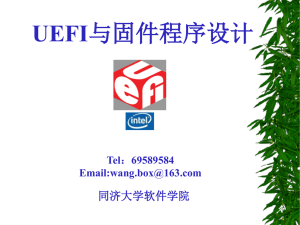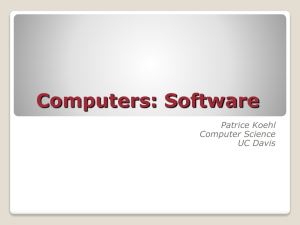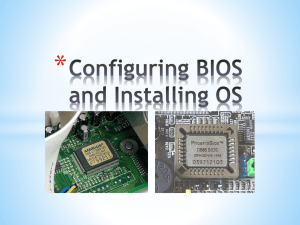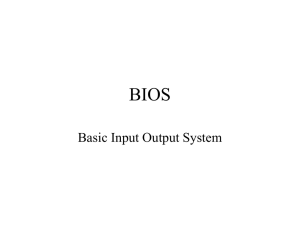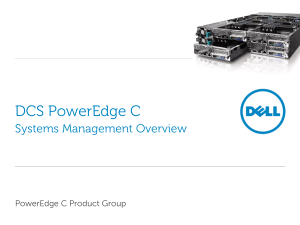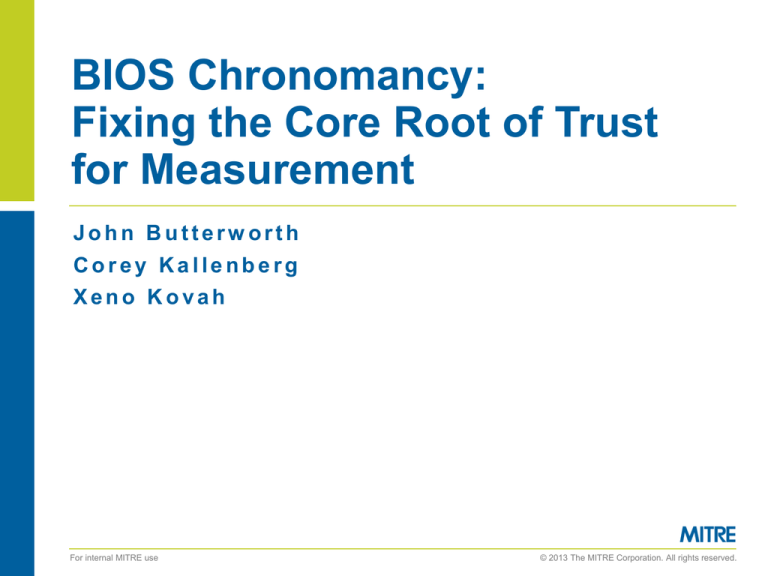
BIOS Chronomancy:
Fixing the Core Root of Trust
for Measurement
John Butterworth
Corey Kallenberg
Xeno Kovah
For internal MITRE use
© 2013 The MITRE Corporation. All rights reserved.
|2|
Introduction
Who we are:
– Trusted computing researchers at The MITRE Corporation
What MITRE is:
– A not-for-profit company that runs six US Government "Federally
Funded Research & Development Centers" (FFRDCs) dedicated to
working in the public good
– The first .org, !(.mil | .gov | .com | .edu | .net), on the ARPANET
– Manager for a number of standards such as CVE, CWE, OVAL,
CAPEC, STIX, TAXII, etc
|3|
Motivation
Why should you care about BIOS security?
– It's the first code that runs on your CPU
– Almost no one is integrity checking the BIOS, so it's a great place for
multi-year backdoors to reside
– BIOS overwrite leads to very annoying/time-consuming to recover
from bricking of machines (CIH Virus)
– It's rarified knowledge, so it's cool :)
We cared because we wanted to know how trusted computing BIOS
security mechanisms work.
– What is actually measured to generate Trusted Platform Module
(TPM)-stored BIOS measurements?
– Can an attacker defeat these measurements?
– How can we build a better root of trust – one that detects an attacker
at the same privilege level as the defender?
Heresy!? Read-on!
|4|
Outline
How an attacker could get into BIOS
How the trusted computing technology of the Core Root of Trust
for Measurement (CRTM) is rooted in the writable BIOS, and
therefore vulnerable to manipulation
BIOS malware (tick, flea) that can subvert TPM-mediated trust
Our defensive strategy – BIOS Chronomancy
Conclusions
|5|
Shoulders of Giants
Firmware shows up in many different contexts
Today we're going to be talking predominantly about x86 PCs'
BIOS firmware
But we're only going to hit about 10 select talks
Here is a timeline that includes more interesting and tangential
things I've had to skip
http://timeglider.com/timeline/5ca2daa6078caaf4
– Or write down http://bit.ly/1bvusqn
|6|
What's been targeted?
|7|
What's been targeted? – intra-architecture
|8|
What's been targeted? – intra-architecture
http://www.intel.com/Assets/PDF/datasheet/316966.pdf
|9|
What's been targeted? – intra-architecture
Intel Active
Management
Technology
(AMT)
http://www.intel.com/Assets/PDF/datasheet/316966.pdf
System Management
RAM
| 10 |
What's been targeted? – intra-architecture
Hard Drive
Controller
Battery
Main BIOS
Option
ROMs
NICs
Keyboard
Controller
http://www.intel.com/Assets/PDF/datasheet/316966.pdf
Keyboard
| 11 |
What's been targeted? – intra-architecture
FTW!
http://www.intel.com/Assets/PDF/datasheet/316966.pdf
| 12 |
What's been targeted? – intra-architecture
SMM
FTW!
http://www.intel.com/Assets/PDF/datasheet/316966.pdf
| 13 |
1998 – CIH/Chernobyl Virus
Just have to mention it :)
One of only two known in-the-wild BIOS-targetting malware
Rendered unbootable ("bricked") machines by writing junk to
the BIOS flash chip
– Also zeroed the first MB of the HD
This attack works against one particular chipset, and assumes
an unlocked BIOS
| 14 |
2006 – Implementing and Detecting an ACPI
BIOS Rootkit – Heasman [8]
The BIOS sets up Advanced Configuration and Power Interface
(ACPI) tables.
The tables have ACPI Machine Language (AML) which is then
read an interpreted by the OS (acpi.sys)
The AML "OperationRegions" construct can be used to read and
write memory
Used AML to do typical type kernel mode rootkit modifications
– Side note: ACPI tables were used by Wojtczuk & Rutkowska [7] to
buffer overflow Intel TXT's SINIT code later in 2011 – showing how
the Dynamic Root of Trust for Measurement can depend on the
Static Root of Trust for Measurement - more about that later
This work assumes an unlocked BIOS
| 15 |
2006 – "Using CPU System Management
Mode to Circumvent Operating System
Security Functions " – Duflot et al. [10]
| 16 |
Utilized x86 CPU's System Management Mode (SMM) to defeat
OpenBSD's secure levels limitations on superuser privileges
The notion that code running in SMM can be invisible to, and more
privileged than, OS (or even hypervisor) code lead to a great
expansion of interest in SMM
At the time, SMM was generally unlocked (D_LCK = 0), but BIOS
vendors started turning on this access control
– This lead to work on how to break into SMM, including the
independent discovery by Duflot et al.[11] and Wojtczuk &
Rutkowska[12] that it was possible to write to SMRAM by
manipulating CPU caching
– This is a CPU architectural flaw that could only be fixed by newer
CPUs
BIOS instantiates SMM, so generally a BIOS compromise indicates
an SMM compromise but not vice versa
– However we recently disclosed an exception to this rule [13]
From [10]
| 17 |
| 18 |
2007 – Implementing and Detecting a PCI
Rootkit – Heasman [9]
Not PCI so much as PCI Expansion ROM (XROM)
XROMs are bits of code that exist in PCI family peripherals
The code is meant to provide initialization for the peripheral when
used with a BIOS that doesn't know about the hardware
– It is essentially trying to enable plug and play for expansion cards
XROM code is automatically searched for and executed by the main
BIOS
Ergo, if you want write to an XROM, you can get code execution in
the context of the BIOS
This was more like a concept talk, because as best we can tell, he
didn't actually implement anything
Our preliminary evidence indicates true *direct* (that is, non-
memory mapped) XROM read/write to be fairly vendor-specific. But
we're currently investigating this. We'll let you know at a future con
;)
This work assumes an open XROM flash
| 19 |
2009 – Persistent BIOS Infection – Sacco &
Ortega [15]
Discussed the practicality of BIOS infection
Explained that because the boot block will generally be
decompressed x86 asm (and contain a decompressor for other
sections), it serves as a good target for infection
Also showed infection of the VMware virtual BIOS file
– which is nice and easy to understand because there's a GDB stub
built into vmware that lets you break at the very first instruction.
Normal BIOS researchers and attackers do not have that luxury
This work assumes an unlocked legacy BIOS
| 20 |
| 21 |
2009 – Deactivate the Rootkit – Ortega &
Sacco [16]
Described the CompuTrace software which is embedded in
some OEM BIOSes.
It is anti-theft software ("a laptop lo-jack") which is meant to
exist in the BIOS, load itself into the OS (even if the thief
changes/reformats the hard drive), and then beacon out to
CompuTrace's server, so they can try to find your stolen laptop
The software is generally disabled by default, and requires
changing a BIOS setting to enable
An interesting thing here is that the software has a mini-NTFS
driver embedded in it, so that it can drop an EXE into the
filesystem, and register it as a Windows service.
The problematic thing here is that the CompuTrace BIOS code
reads and executes unauthenticated (only CRCed!) code from
the HD in space outside the partitions, allowing an attacker to
potentially get arbitrary BIOS code execution across a wide
range of BIOSes (whatever has CompuTrace embedded)
| 22 |
| 23 |
2009 – Attacking Intel BIOS – Wojtczuk &
Tereshkin [1]
Explained that for properly secured systems, the BIOS reboots into
an open state, checks for BIOS update, and then locks down the
system post-update (if any)
This gives very few opportunities for an attacker to provide
malicious input to the BIOS to try to gain code execution.
But it turns out that there is some parsing involved in handling
unsigned subcomponents of the UEFI flash filesystem…
In particular, the user-customizable BIOS splash screen
They consequently leveraged a parsing error in BMP processing to
gain arbitrary code execution in the context of the BIOS, and
subsequently reflash the BIOS (without having a valid, signed, BIOS
update)
This work assumes a non-writable, signed, UEFI
BIOS! Awesome work!
(although, having the TianoCore UEFI reference source code did
make it a little easier on them than we had it for our bug ;))
| 24 |
| 25 |
2011 – Sticky Finger & KBC Custom Shop –
Gazet [17]
This lesser-known work was also very good. The presentation
had a great snowballing effect where it just kept building to
more and more power
First analyzed how his BIOS recovery password worked
Found that it involved SMM and the Keyboard Controller (KBC)
Looked at a KBC update and 1) figured out the architecture
(ARCompact) 2) adapted their disassembler to display it and 3)
subsequently reflashed the KBC with custom code (no access
controls, just required a lot of RE)
Then analyzed the SMM code and found that there is a buffer
overflow when SMM talks to the KBC!
Persisting in the KBC *and* breaking back into SMM? Delightful!
Assumes no KBC locks. We've been told newer KBCs have
more access controls but we haven't looked into it further.
| 26 |
| 27 |
2012 - DE MYSTERIIS DOM JOBSIVS Mac EFI
Rootkits – Snare [18]
Apple was the first major vendor to adopt EFI, when they first
released their Intel Macs
Unfortunately they are late to the game with implementing the
newer UEFI specs such as 2.3.1's UEFI Secure Boot
– All Macs have openly writable BIOSes, but…
– "Anecdotal evidence has indicated that Mac systems also contain
a 'boot ROM', which is executed before the EFI firmware and
verifies the integrity of the firmware image including its
cryptographic signature at the end of the firmware volume. If the
firmware image is not deemed to be valid, the system generates
the 'S.O.S.' beep sound (literally 'S O S' in Morse code) and
refuses to boot. The author has not explored this any further;
however, it may be a future area of research."
Showed persistence through patching the bootloader and
rewriting an XROM
– Then showed patching the OS kernel from both those places
Behold your attacker…
| 28 |
From [18]
| 29 |
2011 – Mebromi[14]
The other known in-the-wild BIOS-infecting malware
Discovered in Sept. 2011
Based on IceLord's 2007 proof of concept Award BIOS infector
Is in the BIOS primarily for persistance of installation of
standard Master Boot Record (MBR)-based kernel infector.
– Does IRP hooks to hide files on disk
This malware assumes an open and writable Legacy BIOS
2013 – Evil Maid Just Got Angrier: Why Full-Disk Encryption With
| 30 |
TPM is Insecure on Many Systems – Bulygin [3], A Tale of One
Software Bypass of Windows 8 Secure Boot – Bulygin et al. [4]
Showed that ASUS UEFI systems are not properly setting BIOS
access controls
[3] shows that you can use this to modify the BIOS without TPMstored measurements changing, thus defeating BitLocker
– Which is fundamentally about a poor S-CRTM implementation, but
it wasn't discussed what regions the S-CRTM actually measures
[4] shows that you can use this to disable Windows 8 Secure
Boot
– Also hinted that the vulnerability was more wide-spread, and
hinted at, but didn't disclose, another technique for defeating
Secure Boot from userspace
Provides initial evidence that BIOSes are more open than people
think. We thought these sorts of problems were behind us, but
since they're clearly not, this is part of why we made Copernicus
| 31 |
| 32 |
2013 – BIOS Chronomancy – Butterworth et
al.[18], Defeating Signed BIOS Enforcement –
Kallenberg et al. [13]
| 33 |
We found the 2nd ever signed-bios-bypassing exploit
– And then we found a bunch of easier ways to attack than exploits
We show that once an attacker is in the BIOS, he can completely
defeat the S-CRTM's TPM-stored measurement
– We call this BIOS parasite a tick
We also show that trying to just use a standard BIOS
upgrade/downgrade reflash can also be defeated
– We call this BIOS parasite a flea – because it "hops" across BIOS
updates
We propose the BIOS Chronomancy defensive system which
uses timing-based attestation, and which is designed
specifically under the assumption that the attacker is at the
same privilege level (in the BIOS) as the defensive code
| 34 |
http://picforfuns.blogspot.com/2011/01/be-shallow-or-go-deep.html
| 35 |
Getting into BIOS
Access Controls
– There are registers that can prevent writes to the BIOS flash*
– Signed firmware updates
Latitude E6400 BIOS revisions:
– A29 did not protect the flash from direct writes to the firmware flash
from privileged applications
A30 and higher do
– A29 did not provide an option to require signed updates
A30 and higher have the option, on newer Dell’s systems it's required
However, even access controls can fail or be bypassed:
– In 2009 ITL showed that firmware signing can be bypassed in their
"Attacking Intel BIOS" presentation[1]
Until now, the only BIOS talk to bypass signed update with an exploit
*A detailed discussion about these architectural controls is beyond the scope of this presentation
| 36 |
Dell E6400 BIOS Update
1. Firmware update binary (“HDR”) is copied to kernel memory
–
–
2.
3.
4.
Default method is to packetize the HDR file into “rbu packets”
HDR contains more than just the BIOS update (Keyboard
Controller, Management Engine, too)
A bit in CMOS byte 0x78 is flipped
The system is rebooted
BIOS sees CMOS bit is flipped and triggers an SMI to execute
the SMM BIOS Update routine
| 37 |
BIOS Update Routine (1 of 2)
OS Kernel
Driver
$RPK… Packet=1, size=0x400
Copyright 2011 Dell Inc.. A29
$RPK… Packet=2, size=0x1000
00 00 FF FF FF FF FF…
• The Operating System packetizes the new
BIOS image across the address space. Each
packet has a 33 byte rbu_packet header that
describes the contents and order of the BIOS
image information the packet contains.
• A bit is then flipped in CMOS to indicate to
the BIOS upon the next reboot that an update
is pending.
$RPK… Packet=N, size=0x100
EB 39 00 00 00 FF FF FF FF …
| 38 |
BIOS Update Routine (2 of 2)
System Management Mode RAM
SMM Update Routine
Copyright 2011 Dell Inc. A29..
FF FF FF FF FF FF FF FF FF FF
…
…
EB 39 00 00 FF FF FF FF FF FF
$RPK… Packet=N-1, size=0x1000
• Upon reboot, the System Management Mode
update routine scans for the individual rbu
packets and uses them to reconstruct the
complete BIOS image.
• SMM then verifies the reconstructed BIOS
image is signed by Dell before writing to the
flash chip.
00 00 FF FF FF FF FF…
$RPK… Packet=N, size=0x100
EB 39 00 00 00 FF FF FF FF FF …
| 39 |
Attacker Objective and Plan
Reflash BIOS chip with arbitrary image despite signed BIOS
enforcement.
Method: find a memory corruption vulnerability in the parsing of
the BIOS update information (RBU packets). This will allow us to
seize control of SMM and reflash the BIOS chip at will.
The memory corruption vulnerability must occur before the
signature on the bios update image is checked.
SMM parses the 33 byte rbu_packet header that describes
metadata about the BIOS update image. This parsing occurs
before the signature check.
| 40 |
Attack Surface
http://linux.dell.com/libsmbios/main/RbuLowLevel_8h-source.html
| 41 |
Packet Parsing
SMM first locates the RBU packet by scanning for an ASCII
signature upon page aligned boundaries.
Once located, members of the RBU packet are stored in an SMM
data area for use in later calculations…
| 42 |
Curious GEOR?
When reconstructing the BIOS image from the rbu packets, SMM
writes an initialization string “GEOR” to the destination memory
space where the BIOS image is being reconstructed….
| 43 |
RBU Packet Copied
Eventually the portion of the BIOS image described by the RBU
packet is copied to the reconstruction location in memory.
Notice the size parameter (ecx) for the inline memcpy (rep movsd) is
derived from attacker data (g_pktSizeMinusHdrSize).
| 44 |
RBU Packet Parsing Vulnerability
In fact, the copy destination and copy source are also both
derived from attacker data read in from the current rbu_packet.
This is an exploitable buffer overflow.
| 45 |
Lack of Mitigations
System Management Mode is missing all of the traditional
exploit mitigations you would expect to find in modern
applications.
No ASLR, NX, stack canaries, and so on….
This means we can pursue any target with our overwrite, such
as the return address for the rbu packet copying function…
| 46 |
Exploiting the Vulnerability
There are actually a number of constraints on the RBU packet
data that make exploiting this buffer overflow tricky.
| 47 |
Constraints Overview
Our copy destination must point to an area pre-initialized with the
“GEOR” string.
Copy_dest must be lower in memory than the return address.
We can’t overwrite too much lest we die in the inline memcpy and
never return.
Copy source must be positioned such that attacker controlled
data in the address space ends up overwriting the saved return
address.
Others….
| 48 |
More Problems
The source, destination and size operands are all derived from the
same rbu_packet members.
Changing one operand, changes the others.
All of the constraints previously mentioned must be satisfied.
Exploitation of this vulnerability can be modeled as a constraints
solving problem.
| 49 |
Constraints Corollary
An initialization routine populates the “GEOR” string at the
expected copy dest location under “normal” circumstances.
We skip this normal initialization routine by setting
rbu_packet.totPkts to 1 (which as you can see from the above
code, sets totalDataSize=0). If we don’t, the large memset and
GEOR writing operation performed by the initialization routine are
problematic.
This means the expected “GEOR” string won’t naturally occur in
the address space, and we will have to inject it somehow to satisfy
the *copy_dest = “GEOR” constraint.
| 50 |
Faux GEOR
The vulnerable memcpy will only execute if the copy destination
points to a location containing this GEOR string.
We use a Windows kernel driver that performs memory mapped i/o
to write the GEOR string as high up in memory as possible, to
allow us to force copy_dest to be within striking distance of the
return address we want to overwrite.
Like the BIOS update process, we are abusing the fact RAM
remains intact during a soft reboot so the GEOR strings we wrote
will remain in the address space.
| 51 |
RBU Packet Solution
With all those constraints in mind, we brute force an rbu_packet
configuration that allows us to pass the sanity checks and
overwrite the return address gracefully.
| 52 |
Malicious BIOS Update
SMM Update Routine
System Management Mode RAM
Packet Reconstruction Space
Shellcode
Shellcode
Shellcode
….
• The unusually large packet size and packet
sequence number cause the packet
reconstruction area to overflow into SMRAM.
• This allows us to overwrite a return address
inside of SMRAM and gain control of EIP
while in the context of the BIOS update
routine.
$RPK.. Packet=0x83f9, size=0xfffe
Shellcode
Shellcode
…
Shellcode
| 53 |
PoC Demonstration Video
http://youtu.be/V_ea21CrOPM
| 54 |
Vulnerability Conclusion
The vulnerability allows an attacker to take control of the BIOS
update process and reflash the BIOS with an arbitrary image
despite the presence of signed bios enforcement.
Because BIOS is charged with instantiating System
Management Mode (SMM), control of the BIOS implies complete
control of SMM.
Once the attacker has complete control of BIOS and SMM, really
Bad Things can start to happen…
How can we detect attackers in the BIOS?
Trusted Computing Group (TCG)
Static Root of Trust for Measurement (SRTM)
| 55 |
In the PC Client Specification[2], the TCG lays out a strategy for
obtaining measurements of critical boot-time components
– This should detect things like MBR-based bootkits, or even BIOS
attackers
The SRTM is a chain of trust which is built up at boot time from
the BIOS measuring itself, and measuring every other bit of
executable code before control is passed to that code
– Measurements stored in TPM, discussed shortly
All these measurements are typically gained "for free" when the
BIOS is configured to enable the TPM
| 56 |
Terminology
Trusted Platform Module (TPM)
– Supports secure key generation and secure key storage.
– Can “seal” keys or data such that they can only be decrypted if the
PCR set hasn’t changed.
– Can act as a root of trust for reporting by signing a quote of its
current PCR set.
Platform Configuration Register (PCR)
– Store 20 byte hashes representing measurements of the system.
– Are reset to 0x0020 upon reboot.
– Can only be modified with an “Extend” operation.
– Extend_PCR0(data): PCR0new = SHA1(PCR0old || SHA1(data))
| 57 |
Example Measured Boot ("measured boot" != UEFI "secure boot")
Master Boot Record
Peripheral's
Peripheral's
option/expansion
Peripheral's
option/expansion
ROMs
code
option/expansion
ROMs code
ROMs code
Config
Config
Config
Measure 4
Measure 5
Partition Table
Extend PCR5
Extend PCR4
Extend PCR3
Extend PCR2
Extend PCR1
Measure 0
Extend PCR0
BIOS code on flash chip
Core Root of Trust for Measurement
(CRTM)
Measure 1
…
Trusted Platform Module (TPM)
This collection of measurements going forward is the
Static Root of Trust for Measurement (SRTM)
BIOS configuration
in non-volatile RAM
("nvram"/"CMOS")
| 58 |
All roots of trust are not created equal
Tarnovsky attack
PCRs
Our attack
Base diagram from
http://www.intel.com/content/dam/doc/white-paper/uefi-pi-tcg-firmware-white-paper.pdf
| 59 |
Q45 Express Chipset
4GB
0
System RAM
BIOS Region Begin
SPI Flash
www.intel.com/.../datasheet/io-controller-hub-9-datasheet.pdf
| 60 |
Normal E6400 boot sequence 1
4GB
0
SMRAM
System RAM
BIOS Region Begin
Configuration
…
SPI Flash
Boot Block
FFFF_FFF0
Modules
| 61 |
Normal E6400 boot sequence 2
4GB
0
SMRAM
System RAM
PCR0=SHA1(020 | hash)
hashing
…
SPI Flash
Boot Block
TCG Measure (SRTM)
| 62 |
The Problems with PCRs
Opaqueness
– No golden set of PCRs is provided by the OEM.
– No description of what is actually being measured and
incorporated into the PCR values.1
– Homogeneous systems can have different PCR values.2
– Duplicate PCR values are unexpected if they're measuring
different data…
■ Example E6400 PCR Set
1.
2.
The TCG specification gives vague guidelines on what should be incorporated into individual PCR
values, and many decisions are left to the vendor.
Based on our own observation of PCR values across various systems.
| 63 |
E6400 PCR0 (SRTM) Measurement
PCR0 should contain a measurement of the SRTM and other parts
of the BIOS.
In the above diagram, the dark areas represent what the E6400
actually incorporates into the PCR0 measurement.
Only 0xA90 of the total 0x1A0000 bytes (.15%) in the BIOS range
are incorporated, including:
– The first 64 bytes of the 42 compressed modules.
– Two 8 byte slices at 0xDF4513C0 and 0xDF4513C7.
– The SRTM is not incorporated at all.
*BIOS Base is located at FFE6_0000
| 64 |
Implications of the weak SRTM
Measurements for things like PCI option ROMs and BIOS
configuration are not actually captured.
We can modify the majority of the E6400 BIOS without changing
any of the PCR values.
– Yuriy Bulygin presented a similar discovery at CanSecWest 2013
regarding his ASUS P8P67[3], but did not investigate the details of
what information was being measured into what PCRs
What if we want to modify any part of the BIOS under the
assumption that the entire BIOS is being measured?
| 65 |
Forging the PCRs
We can arbitrarily modify any part of the BIOS while still
maintaining the expected PCR set if we do the following:
1. Record the expected hashes that the SRTM calculates and
forwards to the TPM for the PCR_Extend operation(s).
2. Modify the BIOS to prevent the legitimate SRTM from being
called.
3. Insert your own SRTM which simply replays the aforementioned
“expected” hashes to the TPM.
This method maintains a valid PCR set even if the SRTM
incorporates the entire BIOS into the measurement.
| 66 |
3 Firmware Malware Types
All firmware malware is resident on the NVRAM firmware and is
therefore persistent
Naïve
– That which can be detected by simply observing PCRs
Tick
– Embeds itself in the firmware
– Evades detection by forging PCRs
– Once in place, can modify any other portion of the BIOS (even
injecting itself into SMM)
Flea (to be discussed shortly)
| 67 |
Normal BIOS PCR0 Measurement
4GB
0
System RAM
PCR0=SHA1(020 | 0xf005b411…)
BIOS
SHA1(self)
SPI Flash
0xf005b411…
| 68 |
PCR0 Measurement with a Tick
4GB
0
System RAM
PCR0=SHA1(020 | 0xf005b411…)
BIOS
SHA1(self)
SPI Flash
| 69 |
Tick Demo Video
| 70 |
Tick Demo Video
http://youtu.be/S0lRcm3jvFo
Narrative: (for those watching offline)
– Show how a stealth rootkit can evade detection by forging PCR0
Bootup of a healthy E6400 laptop, with stock BIOS.
– Notice the original Dell splash screen. The module that contains this splash screen
is measured by the SRTM and thus will trigger a change in PCR0 if it is modified.
Log in:
– Top right of screen will display our kernel driver debug output
– Bottom right text file will contain our read PCR0 hashes
– Run OpenTPM driver to read PCRs, save original (good) PCR0
Install a custom BIOS containing a “naïve” firmware rootkit
– Mods the splash screen, has no stealth capability
– Log in, dump PCRs, new PCR0 does not match good PCR0
Install a custom BIOS containing a “Tick” firmware rootkit
– Also mods the splash screen, does have stealth capability
– Log in, dump PCRs, new PCR0 does match PCR0.
– Tick is now free to modify any other portion of the firmware without ever being
detected.
| 71 |
The Flea
All the same stealth capabilities of the Tick
Achieves persistence beyond BIOS re-flashes
– “Jumps” from one BIOS revision to another
| 72 |
The Flea
4GB
0
BIOS Firmware
Update
System RAM
Flash!
Clone!!
BIOS
SPI Flash
BIOS update?
| 73 |
Flea Demo Video
| 74 |
Flea Demo Video
http://youtu.be/fvQjhqzxHR8
Narrative: (for those watching offline)
– Show how the flea persists beyond BIOS updates
– Not showing the stealth capabilities (same as Tick)
E6400 laptop already has a Flea present in its firmware
– Mode of entry is same as the Tick (installed via kernel driver)
– BIOS Revision A29
Install the manufacturers Stock BIOS Update
– Will update to BIOS revision A30
BIOS updates to revision A30 and reboots
On startup we see that the Flea is still present in the malware.
The flea is able to forge the PCR0 value of the BIOS revision it has
cloned itself into. In the interest of time I cut off the video after
showing that the Flea persists.
Countermeasure:
Timing-Based Attestation
"BIOS Chronomancy"
| 75 |
The fundamental premise:
– "Build your software so that if its code is modified, it runs slower."
We coined "timing-based" because it is a superset of the
"software-based" techniques, but using hardware (e.g. TPM) for
timing measurement
Meant to replace CRTM, but not reimplement entire SRTM
Assumptions:
– Attacker has complete control of execution environment before
self-checking begins (i.e. same privilege as defender)
– Self-checking code is time-optimal for a given microarchitecture
– There are no free execution slots where an attacker can insert a
"free" instruction and suffer no timing slowdown
There is a decade of work in this area, we can't do the many
many nuances justice. A timeline of related work here:
– bit.ly/11xEmlV (timeglider.com link)
| 76 |
Components of All Self-Checks
Read your own data
– Incorporated into checksum so if it changes the checksum
changes
Read your own data pointer and instruction pointer
– Indicates where in memory the code itself is reading and executing
Nonce/PseudoRandom Number(PRN)
– Prevent trivial replay, decrease likelihood of precomputation due to
storage constraints
Do all the above in millions of loop iterations
– So that ideally an instruction or two worth of conditional checks per
loop iteration leads to millions of extra instructions in the overall
runtime
| 77 |
Simplified Selfcheck()
Selfcheck(checksum, nonce, codeStart, codeEnd, codeSize) {
while (iteration < 2500000)
{
checksum[0] += nonce;
checksum[1] ^= DP;
checksum[2] += *DP;
checksum[4] ^= EIP;
mix(checksum);
nonce += (nonce*nonce) | 5;
DP = codeStart + (nonce % codeSize);
iteration++;
}
}
| 78 |
Simplified Selfcheck() Forgery
Selfcheck_forge(checksum, nonce, codeStart, codeEnd, codeSize) {
while (iteration < 2500000)
{
checksum[0] += nonce;
checksum[1] ^= DP;
if (DP == myHookLocation)
checksum[2] += copyOfGoodBytes;
else
checksum[2] += *DP;
checksum[2] += *DP;
checksum[4] ^= EIP;
mix(checksum);
nonce += (nonce*nonce) | 5;
DP = codeStart + (nonce % codeSize);
iteration++;
}
}
TPM-Timing Based Implementation
(BIOS Boot-Time)
Server
Client
| 79 |
TPM
Time
BOOT
Δt
Self-Check (nonce = signature)
Separate agent requests stored
measurement, and sends to server
for verification
18 E6400s with customized BIOS Chronomancy firmware
625k self-check iterations
| 80 |
17300
17200
TPM Ticks
17100
17000
16900
16800
Without attacker
With attacker
16700
1
3
5
7
9
11 13 15 17 19 21 23 25 27 29 31 33 35 37 39
Measurement Instance
18 E6400s with customized BIOS Chronomancy firmware
1.25M self-check iterations
| 81 |
22200
22000
TPM Ticks
21800
Without attacker
21600
21400
With attacker
21200
21000
1
3
5
7
9
11 13 15 17 19 21 23 25 27 29 31 33 35 37 39
Measurement Instance
18 E6400s with customized BIOS Chronomancy firmware
2.5M self-check iterations
| 82 |
33000
32500
TPM Ticks
32000
31500
Without attacker
31000
30500
With attacker
30000
29500
1
3
5
7
9
11 13 15 17 19 21 23 25 27 29 31 33 35 37 39
Measurement Instance
BIOS Chronomancy – attacker overhead vs. clean measurement
18 E6400s, 20 measurements, 3 different loop iteration counts
(1 tick = 64 μsec)
Takeaway: If you only do 625k iterations, occasionally the attacker wins.
83
With 1.25M or more the attacker doesn't even get close.
Is BC perfect? NOPE!
TOCTOU attackers are ongoing work
| 84 |
Enter the "flash hopper" :P
4GB
0
System RAM
BIOS
Gbe LAN
SPI Flash
Self-check
Done
| 85 |
Conclusion
Assume attackers can get in
Bad things happen when attacker get in
Trusted Computing implementations should not be trusted
implicitly, they should only be trusted if they are open for
independent review (and someone has actually reviewed them ;)
– It's ironic that they're overwhelmingly closed source & proprietary.
(Even academics don't usually post their code for open review!1)
As long as the CRTM is implemented in writable firmware, ticks
and fleas will mean that you can't trust any of your SRTM.
– And as ITL has shown, a TXT-based Dynamic RTM can depend, in
a security-critical way, on the BIOS/SRTM-generated info [5][6][7]
– If you're not going to be using BC, you better be using super
simple true ROM CRTM code
1
Our code for our self-check is at http://code.google.com/p/timing-attestation
| 86 |
Conclusion deux!
We need more people working in this space!
You should try your hand at making and breaking
timing-schemes1.
It's obviously a very challenging and cool defensive
security area
1
Again, our code for our self-check is at http://code.google.com/p/timing-attestation
| 87 |
But wait…there's just One More Thing!
We have released Copernicus ("Question your assumptions!"), a
tool to check for basic BIOS/SMM security vulnerabilities
– http://www.mitre.org/work/cybersecurity/blog/cyber_tools_butterworth1
.html
– Checks configuration bits to see if the BIOS/SMM is writable, ala
Yuriy's talks[3][4]
Dumps BIOS image to allow diffing & analysis
– Can detect Rakshasa, last year's "undetectable" BIOS malware[7] ;)
Government organizations:
– Talk to us about running this in your environment (pushable via HBSS
- but the data goes to a different server, not ePO)
Commercial security vendors:
– Contact us to incorporate Copernicus's capabilities into your
kernel/hypervisor agents. We want maximum availability of this
capability. MITRE is a not-for-profit company that only works for the
government in the public interest.
| 88 |
Questions?
jbutterworth, ckallenberg, xkovah @ mitre.org
To learn more about TPMs, Reverse Engineering, and other deep
security stuff, check out
http://OpenSecurityTraining.info/Training.html
– John will be creating BIOS/UEFI classes this coming year, follow
@OpenSecTraining to keep up with news
– And if you already know the stuff, take the materials and teach it!
Also Corey released OpenTPM so you too can play around with
and learn more about the TPM
http://code.google.com/p/opentpm/
| 89 |
References
[1] Attacking Intel BIOS – Alexander Tereshkin & Rafal Wojtczuk – Jul.
2009http://invisiblethingslab.com/resources/bh09usa/Attacking%20Intel%20BIO
S.pdf
[2] TPM PC Client Specification - Feb.
2013http://www.trustedcomputinggroup.org/developers/pc_client/specifications/
[3] Evil Maid Just Got Angrier: Why Full-Disk Encryption With TPM is Insecure
on Many Systems – Yuriy Bulygin – Mar. 2013
http://cansecwest.com/slides/2013/Evil%20Maid%20Just%20Got%20Angrier.pdf
[4] A Tale of One Software Bypass of Windows 8 Secure Boot – Yuriy Bulygin –
Jul. 2013 http://blackhat.com/us-13/briefings.html#Bulygin
[5] Attacking Intel Trusted Execution Technology - Rafal Wojtczuk and Joanna
Rutkowska – Feb.
2009http://invisiblethingslab.com/resources/bh09dc/Attacking%20Intel%20TXT%
20-%20paper.pdf
[6] Another Way to Circumvent Intel® Trusted Execution Technology - Rafal
Wojtczuk, Joanna Rutkowska, and Alexander Tereshkin – Dec.
2009http://invisiblethingslab.com/resources/misc09/Another%20TXT%20Attack.
pdf
[7] Exploring new lands on Intel CPUs (SINIT code execution hijacking) - Rafal
Wojtczuk and Joanna Rutkowska – Dec.
2011http://www.invisiblethingslab.com/resources/2011/Attacking_Intel_TXT_via_
SINIT_hijacking.pdf
[7] Meet 'Rakshasa,' The Malware Infection Designed To Be Undetectable And
Incurable - http://www.forbes.com/sites/andygreenberg/2012/07/26/meetrakshasa-the-malware-infection-designed-to-be-undetectable-and-incurable/
| 90 |
Backup slides
Copernicus:
"Question your assumptions
(about BIOS security)"
Sam Cornwell, John Butterworth, Xeno Kovah ,
Corey Kallenberg
For internal MITRE use
© 2013 The MITRE Corporation. All rights reserved.
| 92 |
Motivations
We want to know if a BIOS is writable
We want to be able to integrity check the BIOS
– We want our integrity checks to be more actionable than "the hash
changed. Do 'something' about it."
We want BIOS integrity checking to be a widely available
capability for both industry and our government sponsors
We want to know what the state of the wild for BIOS security
looks like right now
Copernicus is available now for you to play around with!
http://www.mitre.org/capabilities/cybersecurity/overview/cyberse
curity-blog/copernicus-question-your-assumptions-about or
http://bit.ly/19rYHin
Please contribute your data back to us
| 93 |
BIOS Access Control Checking
BIOS makers are supposed to set certain access control bits
that are scattered around a number of hardware registers. These
bits should make it so that no one can write to the BIOS flash
chip until next reboot.
Unfortunately vendors don't always set these bits correctly, and
the BIOS can therefore be written to directly by anyone with
admin privileges
Copernicus checks these bits and reports whether a BIOS flash
chip is open for modification
| 94 |
Running Copernicus Video
standalone.bat
http://www.youtube.com/watch?v=zZe88jW9PuE
Running Copernicus 2
| 95 |
Running Copernicus 3 – .csv output
| 96 |
| 97 |
Running Copernicus 4 – .log output
| 98 |
BIOS/SMRAM Writability Analysis Video
protections.py
Public youtube link will be added later
| 99 |
Example Analysis Results
We've tested on > 8k machines from various organizations so far
~55% have unlocked BIOS
COUNT BIOS_VENDOR PRODUCT_NAME
BIOS_VERSION
SMRAM_UNLOCKED BIOS_UNLOCKED
7
Dell Inc.
Latitude E6400
A25
0
7
3
Dell Inc.
Latitude E6400
A27
0
3
10
Dell Inc.
Latitude E6400
A29
0
10
7
Dell Inc.
Latitude E6400
A30
0
0
1
Dell Inc.
Latitude E6400
A31
0
0
2
Dell Inc.
Latitude E6400
A32
0
0
1
Dell Inc.
Latitude E6400
A33
0
0
| 100 |
Possible Defenses
For some machines (such as the Dell E6400), newer BIOS
updates have the access controls set
– Rev A29 is open & vulnerable, Rev A30 and newer aren't
We are collecting a more comprehensive matrix of which models
and BIOS revisions are secure
This can be the basis for determining whether to perform
enterprise-wide BIOS updates
When we find enough machines for which there is no BIOS
update fix, we can go to the vendor and ask them to fix this
| 101 |
Looking for BIOS Changes
If a difference is found, now what are you going to do?
We want to be able to attribute changes in a hash to specific
locations in the BIOS image that changed.
We need to be able to compare the before and after raw
BIOS dumps. We can then say something about the
purpose of the location where the change occurred, and
whether it's expected or not.
– This helps tamp down false positives
Copernicus gives us a BIOS dump, and therefore an
integrity checking capability!
| 102 |
BIOS Change Detection Video
bios_diff.py
http://www.youtube.com/watch?v=XaeMrL1LqPo
| 103 |
PCR Change Response with Copernicus
Now when a BIOS change is found it can be in detail, and most
importantly it is now actionable.
UEFI firmware is compiled from C code into Microsoft's Portable
Executable format.
Therefore Windows reverse engineering skills from other people
(such as malware analysts) can be reused to understand UEFI
changes.
– "Just" need to read some UEFI specs
We will be making classes to help existing reverse engineers be
able to understand UEFI binaries, and posting them to
OpenSecurityTraining.info in the future
| 104 |
BIOS Static Analysis in IDA Video
IDA
http://www.youtube.com/watch?v=R-5UO6jLkEI
| 105 |
BIOS Static Analysis in IDA 2
Clean BIOS TPM module entry point
Attacked BIOS TPM module entry point
A single byte change means the TPM module
will immediately return, and never initialize
the TPM for early-system use
| 106 |
BIOS Static Analysis in IDA 3
UEFI BIOSes make use of a number of specified
data structures. Snare extracted some of these
structures into "behemoth.h", which can then be
imported into IDA
| 107 |
BIOS Static Analysis in IDA 4
Because the BIOS is written in 32 bit C, Hexrays can be used to decompile
When we apply structure definitions from behemoth.h, we now
know the function which is being called; in this case, InstallPpi()
| 108 |
BIOS Static Analysis in IDA 5
Some other pseudocode made more readable thanks to applying structures
This translates to
If(LocatePpi() succeeds){
GetBootMode()
do some other functions
InstallPpi()
etc
}
Which is much easier to read than a bunch of handcoded assembly
| 109 |
BIOS Static Analysis in IDA 6
If we have data locations which the structures say are UEFI_GUIDs
We can look the GUID up in a list of GUIDs extracted from the UEFI
reference implementation and see if it's a well-known GUID
In this case, if we didn't already suspect this module had to do with the
TPM, the fact that it's installing a PPI named "TPM_INITIALIZED"
would be a dead giveaway.
| 110 |
Conclusion
Assume attackers can get in
Bad things happen when attackers get in
Trusted Computing implementations should not be trusted
implicitly, they should only be trusted if they are open for
independent review (and someone has actually reviewed them ;)
– It's ironic that they're overwhelmingly closed source & proprietary.
(Even academics don't usually post their code for open review!1)
As long as the CRTM is implemented in writable firmware, ticks
and fleas will mean that you can't trust any of your SRTM.
– And as ITL has shown, a TXT-based Dynamic RTM can depend, in
a security-critical way, on the BIOS/SRTM-generated info [5][6][7]
– If you're not going to be using BC, you better be using super
simple true ROM CRTM code
1
Our code for our self-check is at http://code.google.com/p/timing-attestation
| 111 |
References
[1] Attacking Intel BIOS – Alexander Tereshkin & Rafal Wojtczuk – Jul.
2009http://invisiblethingslab.com/resources/bh09usa/Attacking%20Intel%20BIO
S.pdf
[2] TPM PC Client Specification - Feb.
2013http://www.trustedcomputinggroup.org/developers/pc_client/specifications/
[3] Evil Maid Just Got Angrier: Why Full-Disk Encryption With TPM is Insecure
on Many Systems – Yuriy Bulygin – Mar. 2013
http://cansecwest.com/slides/2013/Evil%20Maid%20Just%20Got%20Angrier.pdf
[4] A Tale of One Software Bypass of Windows 8 Secure Boot – Yuriy Bulygin –
Jul. 2013 http://blackhat.com/us-13/briefings.html#Bulygin
[5] Attacking Intel Trusted Execution Technology - Rafal Wojtczuk and Joanna
Rutkowska – Feb.
2009http://invisiblethingslab.com/resources/bh09dc/Attacking%20Intel%20TXT%
20-%20paper.pdf
[6] Another Way to Circumvent Intel® Trusted Execution Technology - Rafal
Wojtczuk, Joanna Rutkowska, and Alexander Tereshkin – Dec.
2009http://invisiblethingslab.com/resources/misc09/Another%20TXT%20Attack.
pdf
[7] Exploring new lands on Intel CPUs (SINIT code execution hijacking) - Rafal
Wojtczuk and Joanna Rutkowska – Dec.
2011http://www.invisiblethingslab.com/resources/2011/Attacking_Intel_TXT_via_
SINIT_hijacking.pdf
[7] Meet 'Rakshasa,' The Malware Infection Designed To Be Undetectable And
Incurable - http://www.forbes.com/sites/andygreenberg/2012/07/26/meetrakshasa-the-malware-infection-designed-to-be-undetectable-and-incurable/
| 112 |
References 2
[8] Implementing and Detecting an ACPI BIOS Rootkit – Heasman, Feb.
2006http://www.blackhat.com/presentations/bh-europe-06/bh-eu-06Heasman.pdf
[9] Implementing and Detecting a PCI Rookit – Heasman, Feb. 2007
http://www.blackhat.com/presentations/bh-dc-07/Heasman/Paper/bhdc-07-Heasman-WP.pdf
[10] Using CPU System Management Mode to Circumvent Operating
System Security Functions - Duflot et al., Mar.
2006http://www.ssi.gouv.fr/archive/fr/sciences/fichiers/lti/cansecwest2
006-duflot-paper.pdf
[11] Getting into the SMRAM:SMM Reloaded – Duflot et. Al, Mar. 2009
http://cansecwest.com/csw09/csw09-duflot.pdf
[12] Attacking SMM Memory via Intel® CPU Cache Poisoning –
Wojtczuk & Rutkowska, Mar.
2009http://invisiblethingslab.com/resources/misc09/smm_cache_fun.p
df
[13] Defeating Signed BIOS Enforcement – Kallenberg et al., Sept. 2013
– URL not yet available, email us for slides
[14] Mebromi: The first BIOS rootkit in the wild – Giuliani, Sept. 2011
http://www.webroot.com/blog/2011/09/13/mebromi-the-first-biosrootkit-in-the-wild/
| 113 |
References 3
[15] Persistent BIOS Infection – Sacco & Ortega, Mar. 2009
http://cansecwest.com/csw09/csw09-sacco-ortega.pdf
[16] Deactivate the Rootkit – Ortega & Sacco, Jul. 2009
http://www.blackhat.com/presentations/bh-usa09/ORTEGA/BHUSA09-Ortega-DeactivateRootkit-PAPER.pdf
[17] Sticky Fingers & KBC Custom Shop – Gazet, Jun. 2011
http://esec-lab.sogeti.com/dotclear/public/publications/11-reconstickyfingers_slides.pdf
[18] BIOS Chronomancy: Fixing the Core Root of Trust for
Measurement – Butterworth et al., May 20
| 114 |
E6400 PCR[1-3]
PCRs 1-3 should contain configuration and option rom
measurements.
Interesting because they are duplicate values.
We had also seen this a89fb8f… value on other (non-E6400)
systems.
PCR[1..3] = SHA1(0x0020 || SHA1(0x00))
| 115 |
Future Work: Combat TOCTOU
Attacker moves out of the way, just in time
| 116 |
Conditions for TOCTOU
1) The attacker must know when the measurement is about to
start.
2) The attacker must have some un-measured location to hide in
for the duration of the measurement.
3) The attacker must be able to reinstall as soon as possible
after the measurement has finished.
It turns out a bunch of the example attacks in the literature are
TOCTTOU without being explicit about it.
And it turns out TOCTOU more severely undercuts the
technique than prior work had recognized
| 117 |
BIOS Acquisition
Method 1: Obtain the BIOS ROM from manufacturer
Dependent on manufacturer
– May not provide straight-forward method to obtain the actual ROM
image
– Dell, for example, no longer provides this handy feature.
| 118 |
BIOS Acquisition
Method 2: Read it from the BIOS chip using software
Write your own if you
want to learn the
architecture very well
Time consuming (but
fun and educational)
Linux app with iopl()
also works well, better
for testing
| 119 |
BIOS Acquisition
Method 3: Read it from the BIOS chip using hardware
Turned out to actually be a requirement …
Not necessarily easy to get at the BIOS chip
| 120 |
BIOS Analysis: Arium CPU Debugger FTW!*
*Some [dis]assembly required.
| 121 |
BIOS Modification: Access Controls 2
BIOSWE can “always”
be set to make the flash
chip writeable (R/W
attributes!)
BLE, however provides
SMRAM the final say as
to whether or not writes
to the flash will be
permitted.
E6400 version A29 didn't set BLE, A30 did


